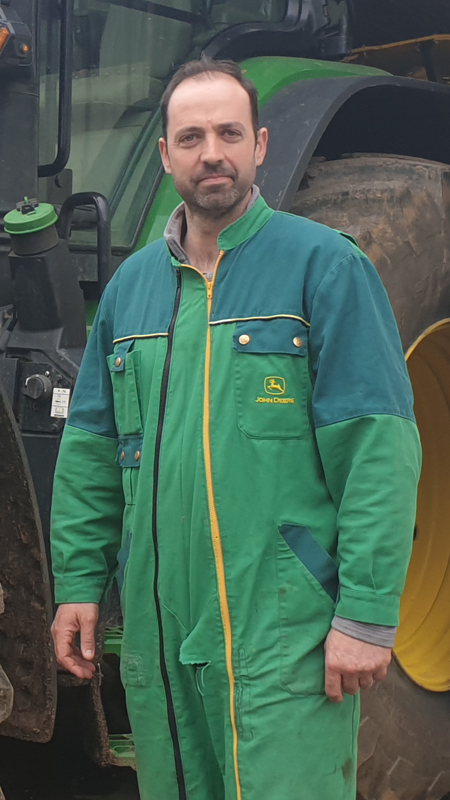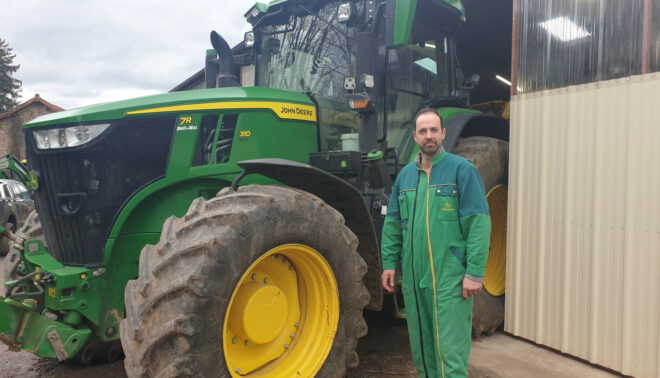Jean-Noël Boissières is a contractor in Siran, in the west of Cantal, close to Lot and Corrèze, France. At an altitude of 500-1000m, the area is dominated by grassland, although grain and maize crops are gaining ground. Public works with four diggers also contribute between 30 and 40% of turnover.
1. Eliminate excess weight
Adding too much weight for jobs requiring little grip or for transport increases fuel usage. Moving 600kg with a 150-horsepower tractor means an estimated 1.5 litres/hr of excess consumption.

Unser Experte zum Thema Kraftstoffverbrauch ist der Lohnunternehmer Jean-Noël Boissières aus Frankreich.
All our tractors are equipped with front hitches, so removing those extra pounds isn’t complicated. I am not a fan of wheel weights for large tractors. For the six-metre trailed seed drill, which we tow with our 7R 310, I prefer a removable rear weight. When this tractor is coupled to the front/rear mower, I obviously strive for the lowest possible weight.
Jean-Noël Boissières
2. Engine oil: Not to be forgotten
Engine oil degrades over time, resulting in higher friction which causes both greater wear and increased fuel usage. As the French machinery magazine Entraid recently mentioned, a specific oil is used for engines equipped with a diesel particulate filter. It is low SAPS, ie low in sulphated ash, phosphorus and sulphur. Using the wrong oil shortens regeneration cycles and increases fuel usage. It can also greatly damage your diesel particulate filter.
Regarding this, for the past 12 years I have had 100% confidence in my dealer, Défi-Mat, from whom I buy all my parts. I meet with the technical manager at least once a year and we review the hardware in order to plan maintenance.
Jean-Noël Boissières
3. Give it clean air
A dirty air filter will increase fuel consumption. Be aware that during one hour of silage-making, the filter will see several hundred thousand litres of air pass through it! Cleaning an air filter using compressed air is tricky: Air volume must be prioritised over pressure, otherwise the filter paper may be damaged. The older the filter gets, the less permeable it will become. Regular replacement increases engine efficiency and reduces fuel consumption.
Every 18 months, or after 2000 hours, we change the air filters. As I said before, this is following agreement with my dealer. And everyone is happy because this collaboration eliminates unpleasant surprises when we discuss the value of a trade-in.
Jean-Noël Boissières
CONSUMPTION ON THE ROAD ACCORDING TO PRESSURE: +/- 18 %
Convoy road configuration: MF 77I8S tractor, 540/65R28 tyres in front (pressure 1 bar) and 650/65R38 at the rear (pressure 2 bar), towing a two-axle trailer weighing 21.3 t (weight and grain)
Tractor mixed configuration: Field/road mixed pressure (1 bar at front and 1.6 bar at rear).

Between the two tested road configurations, the difference is 11 litres per 100 km, or over 18 %.
![]() Speed in km/hr
Speed in km/hr
![]() Consumption in litres/100 km
Consumption in litres/100 km
18% difference in consumption between “road” pressure (2 bar for rear tyres) compared to “mixed” pressure (1.6 bar for the rear), this is the result of a recent test carried out in the south-west of France with the support of the CUMA network in Occitanie.
Source: Entraid’
4. Tyres, an important topic
An important topic and a headache! It is difficult to move away from a compromise between road and field: Under-inflated tyres on the road will increase the rolling resistance, deteriorate the envelopes and consume more fuel. Tyres being overly inflated in the field means you lose out on the advantage from the sidewall deformation and once again skate close to overconsumption. Is there another option than following the manufacturer’s recommendation and getting a good pressure gauge?
My work requires me to do a lot of driving and I have to adapt the pressure to this constraint. For traction in the field, with a 300-horsepower tractor considerable ballast is essential and the weight of the unit is crucial. But I think we’ve reached a plateau and remote inflation will become necessary on tractors with 200 horsepower and above.
I would add that it is not only diesel costs that are going up, but also the price of tyres. Making them last becomes even more important and this is calculated in the global cost of owning a self-propelled unit. It’s likely we will need to think about what level of traction we really require.
Jean-Noël Boissières

Wide drills, not very common in the region, bring new levels of satisfaction to Boissières ETA customers, with new options like “rapid” sowing of grain crops in the autumn or replanting meadows with direct seeding.
5. What about turning the engine off?
Several studies by the CUMA associations (agricultural machinery co-operatives) show that tractors spend 30% of their time at low idle, whether in the coupling/uncoupling stages, during adjustments, when waiting… This is more than 200 hours for a tractor doing 700 hours/year. And for a 150-horsepower tractor, the average consumption when idling is about 3.5 litres/hour!
I regularly make our drivers aware of this phenomenon. Seven of our tractors and two of our forage harvesters are equipped with JDLink telemetry, which gives us a transparent report on engine activity. I found that one of our drivers was using the manual mode for transport rather than the automatic transmission ratio selection.
Is telemetry poisoning the work atmosphere? I don’t think so; we work as a team and with transparency, especially in the face of modern challenges of rapid operating cost increases.
Jean-Noël Boissières
„The JDLink gives me highly accurate information about the cost of my services.“
- Telemetry on the two ETA Boissières forage harvesters which are equipped with it revealed that their consumption is 44 litres/ha in maize, including travel. “I was also able to detail my costs for bale wrapping,” continues the Auvergne contractor. “For example, I already knew that the plastic is €3.30 (£2.74) per bale and the net around 50 cents (42p). This year, we have already had an increase of about one euro (84p) on the plastic, and 20 cents (17p) on the net. But the telemetry let me to see that I was consuming one litre of diesel per bale produced, including travel. I didn’t have such precise information before. It has become essential for managing the company. I would like to thank my dealer who helps me get the most from the telemetry reports.”
6. Width is an asset
Julien Hérault is a machinery consultant and independent trainer at Conseils Agroéquipements consultancy. He notes that due to the lack of sufficiently large implements, the consumption per hectare is too high. In the same vein, Mr Hérault often advocates switching from a mounted implement to a semi-mounted implement based on the following: With a three-metre mounted disk stubble plough, a 120-140 horsepower tractor is usually required to lift the implement at the headland. But when then working in the field, an 80-100 horsepower tractor is entirely capable of doing the same job providing the stubble plough has an axle. Of course, the extra cost of said axle must also be factored in, but with 40 horsepower less when purchasing the tractor, there is some financial leeway.
Personally, it took me two years of deliberating before I decided to part with one of our two three-metre combi drill combines and invest in a six-metre rapid trailed disc drill. This implement really enhances our primary tractor, a John Deere 7R 310. It is fast and versatile, so satisfies a wide range of customers.
We are replanting grassland with grain and maize to scatter vole colonies. And the yields are good, without irrigation. The drill allows the fields to be replenished with direct seeding without tillage, which is very positive for livestock farmers looking to produce their own feed. By securing my customers’ incomes I can protect myself from the risk of non-payments, which is a concern these days!
Jean-Noël Boissières
BOISSIÈRES Rural Contracting Company, an overview

- 10 full-time employees
- 10 tractors including 9 John Deere, from 100 to 310 horsepower
- 3 self-propelled forage harvesters including 2 John Deere 8400 i
- 4 combines including 2 John Deere (W and CTS ranges)
- 2 John Deere C 441 R wrapping balers
- 1 John Deere 864 premium round baler
- 1 L 1534 cubic baler
- 1 9-metre mower
- 4 diggers
- 1 6-metre multi-purpose seed drill
- 1 John Deere Max Emerge planter, 8-row extension

